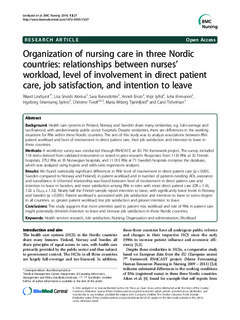| dc.description.abstract | Background Health care systems in Finland, Norway and Sweden share many similarities, e.g. full-coverage and tax-financed, with predominately public sector hospitals. Despite similarities, there are differences in the working situations for RNs within these Nordic countries. The aim of this study was to analyze associations between RNs’ patient workload and level of involvement in direct patient care, their job satisfaction and intention to leave in these countries. Methods A workforce survey was conducted through RN4CAST, an EU 7th framework project. The survey included 118 items derived from validated instruments or tested in prior research. Responses from 1133 RNs at 32 Finnish hospitals, 3752 RNs at 35 Norwegian hospitals, and 11 015 RNs at 71 Swedish hospitals comprise the database, which was analyzed using logistic and odds ratio regressions analyses. Results We found statistically significant differences in RNs’ level of involvement in direct patient care (p < 0.001, Sweden compared to Norway and Finland), in patient workload and in number of patients needing ADL assistance and surveillance. A U-formed relationship was found between level of involvement in direct patient care and intention to leave in Sweden, and more satisfaction among RNs in roles with more direct patient care (OR = 1.16, 1.02 ≤ CI95% ≤ 1.32). Nearly half the Finnish sample report intention to leave, with significantly lower levels in Norway and Sweden (p < 0.001). Patient workload is associated with job satisfaction and intention to leave to some degree in all countries, i.e. greater patient workload, less job satisfaction and greater intention to leave. Conclusions This study suggests that more attention paid to patient mix, workload and role of RNs in patient care might potentially diminish intention to leave and increase job satisfaction in these Nordic countries. Keywords: Health services research; Job satisfaction; Nursing; Organization and administration; Workload | |
